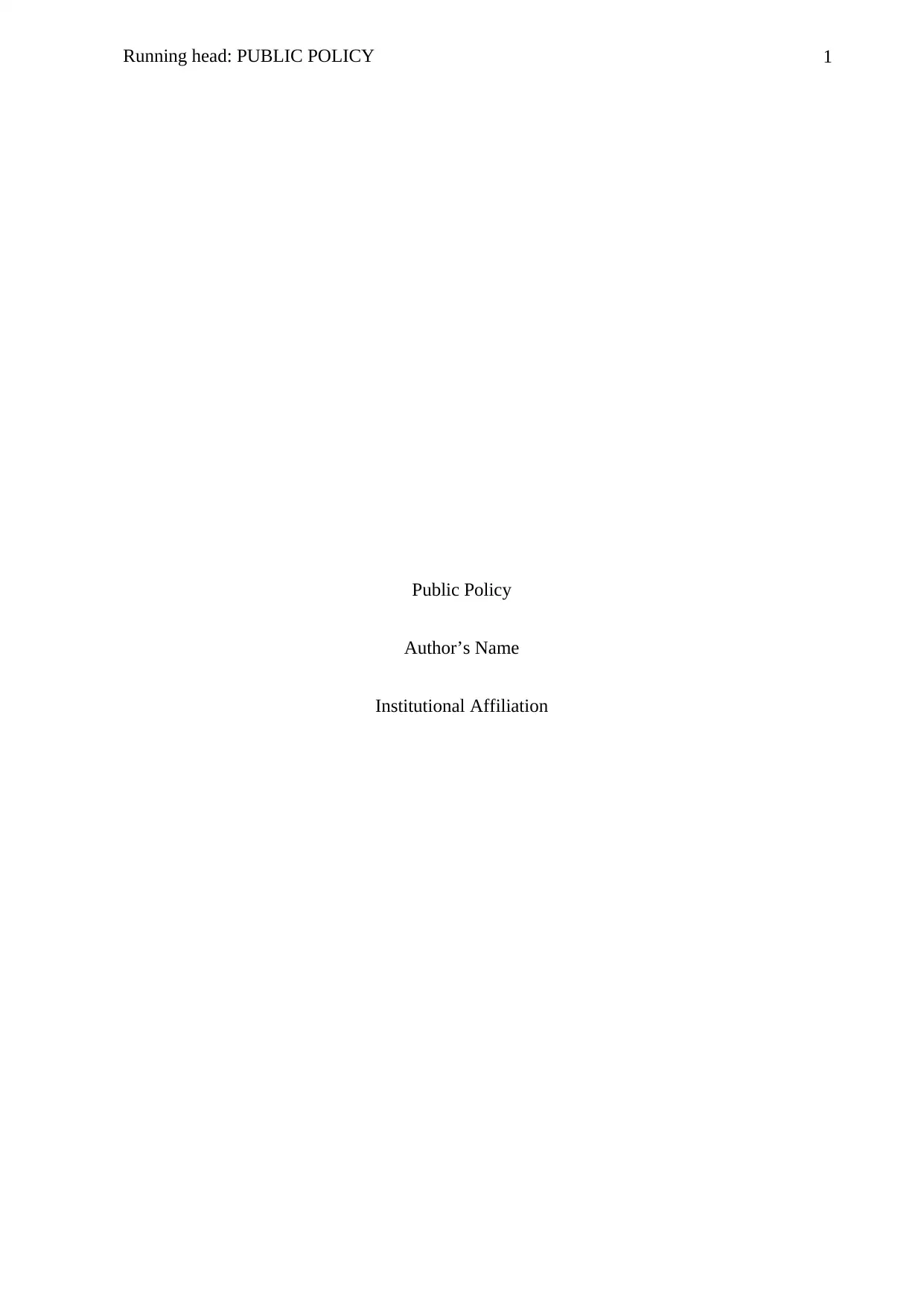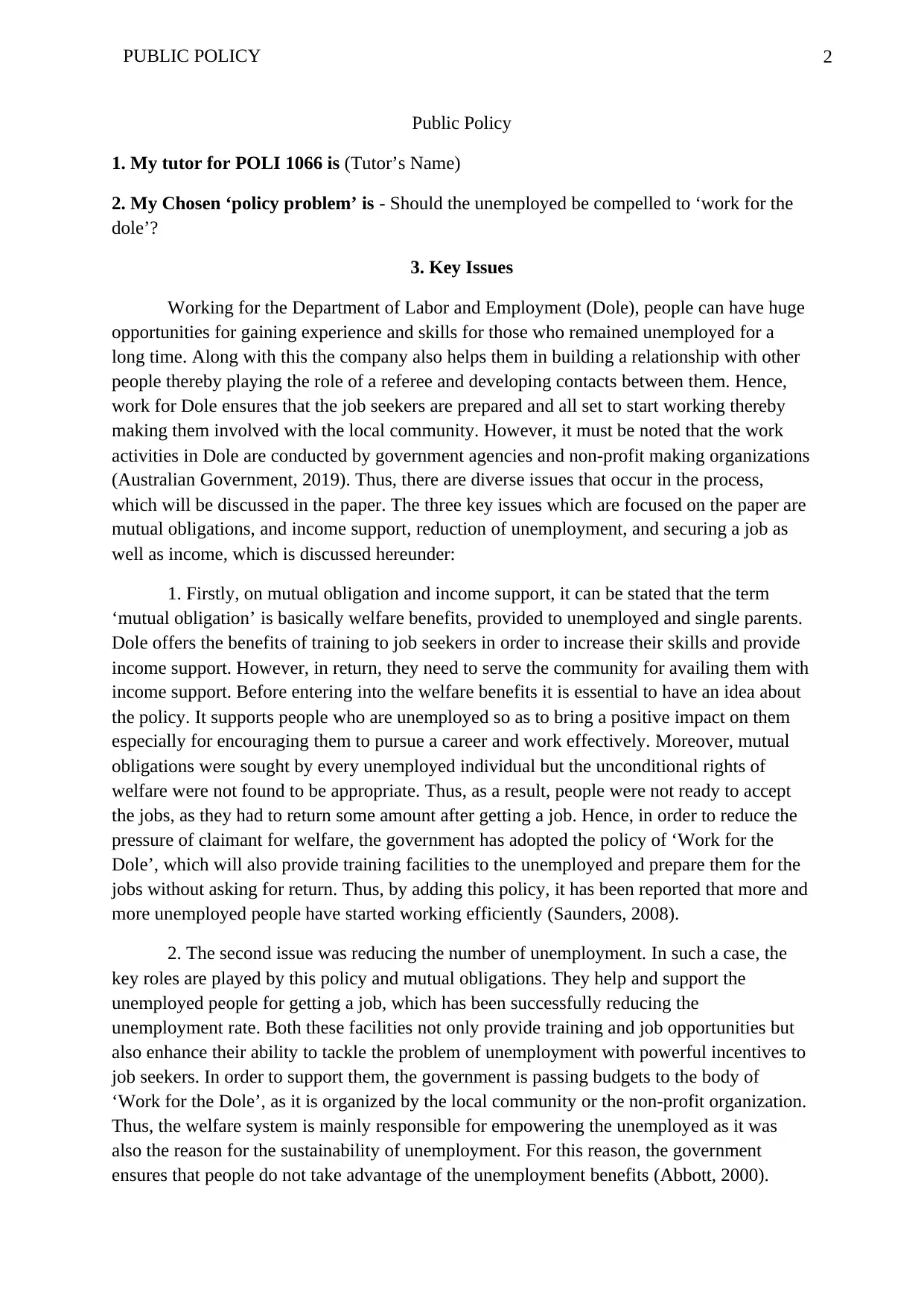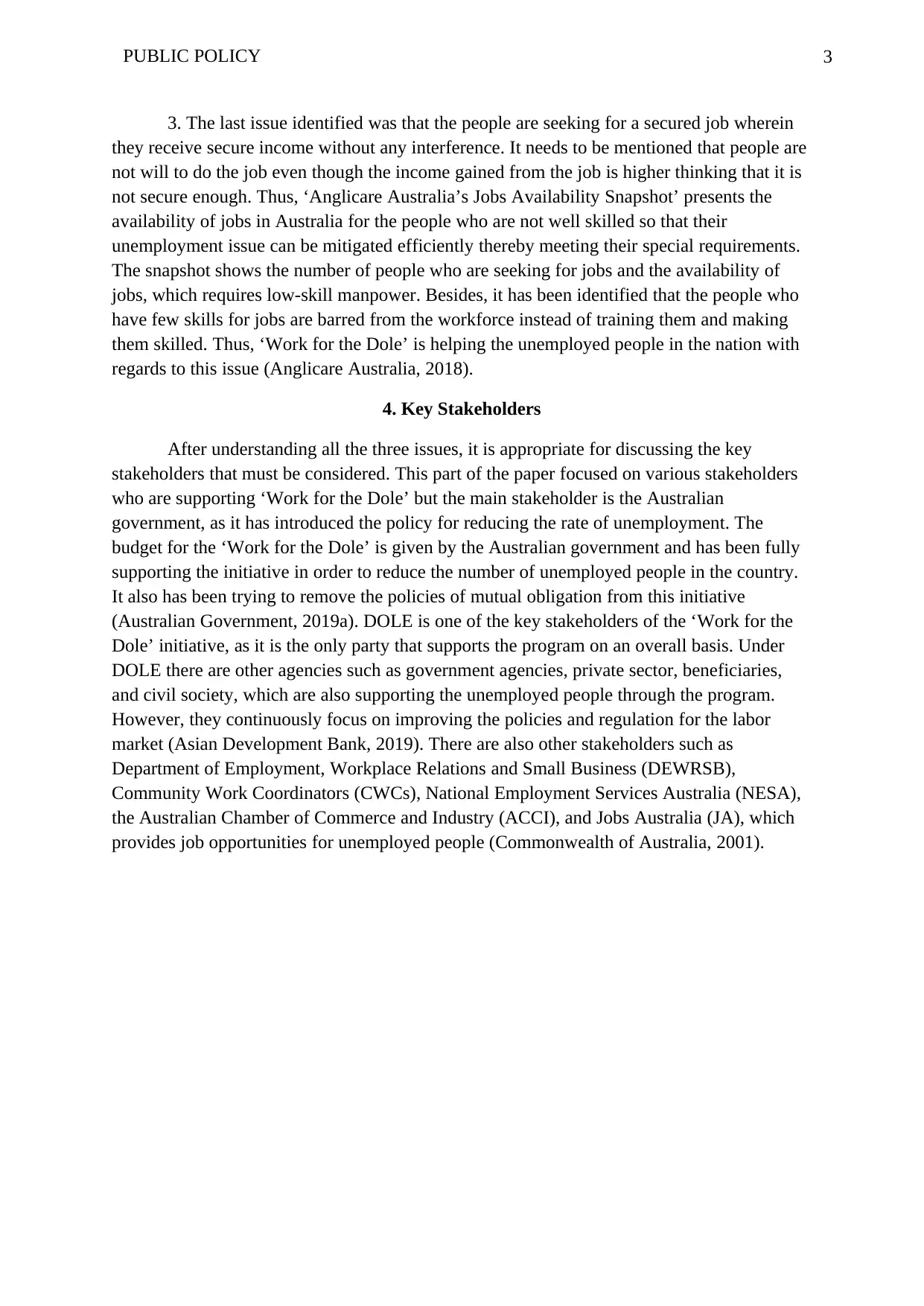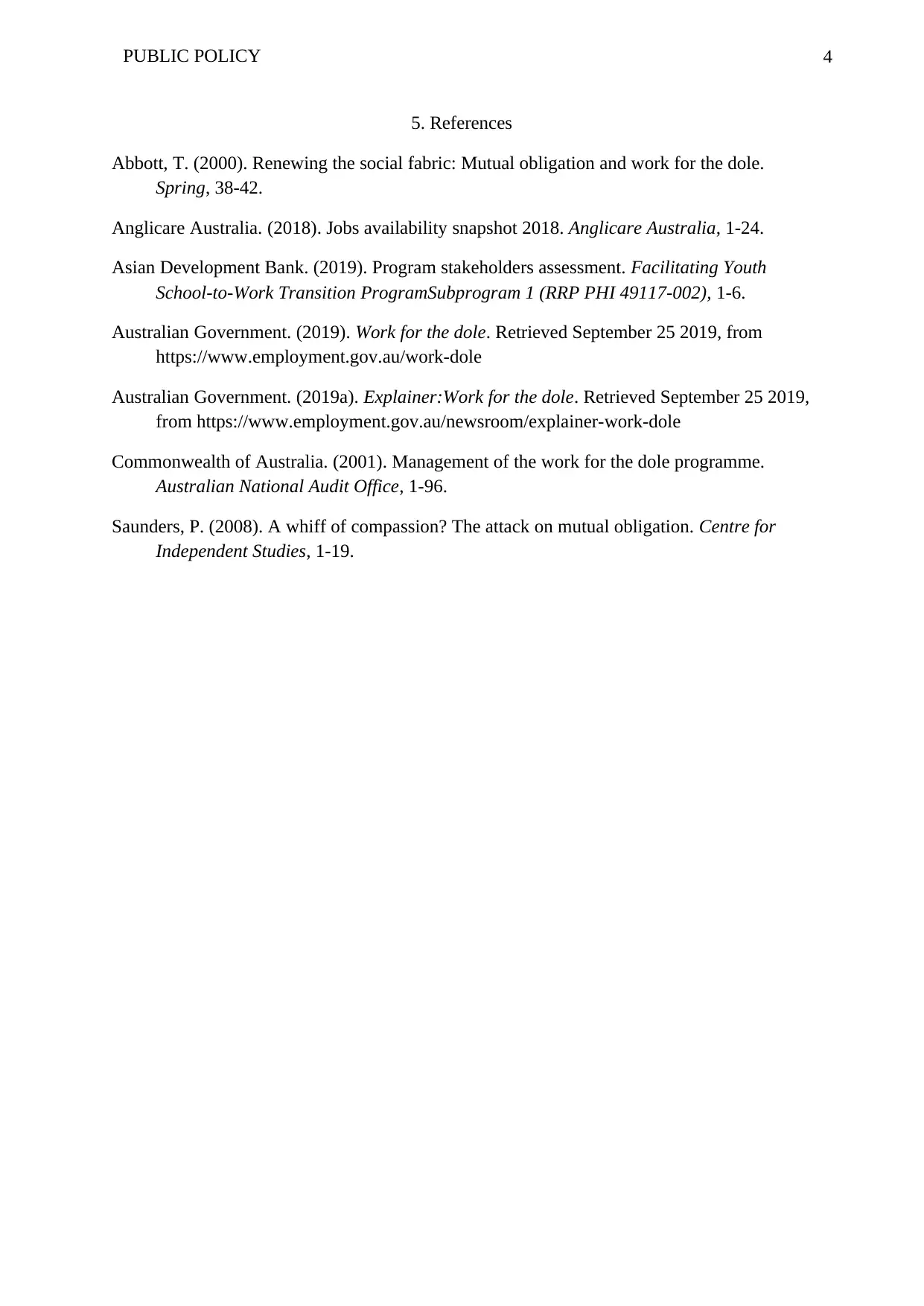POLI1066: Analysis of Public Policy - Work for the Dole Debate
VerifiedAdded on 2022/10/14
|4
|1247
|15
Report
AI Summary
This report examines the public policy of 'Work for the Dole,' focusing on the debate of whether the unemployed should be compelled to participate. It delves into key issues such as mutual obligations, income support, and the reduction of unemployment, highlighting how the policy aims to prepare job seekers and integrate them within the local community. The report analyzes the perspectives of various stakeholders, with a primary focus on the Australian government and the Department of Labor and Employment (DOLE), outlining their roles and responsibilities. The report highlights the significance of 'Work for the Dole' in providing training, securing jobs, and addressing the challenges faced by the unemployed. Furthermore, it references key stakeholders like the Department of Employment, Workplace Relations and Small Business (DEWRSB), Community Work Coordinators (CWCs), and National Employment Services Australia (NESA), to provide a comprehensive understanding of the policy's impact and the stakeholders involved.

1Running head: PUBLIC POLICY
Public Policy
Author’s Name
Institutional Affiliation
Public Policy
Author’s Name
Institutional Affiliation
Paraphrase This Document
Need a fresh take? Get an instant paraphrase of this document with our AI Paraphraser

2PUBLIC POLICY
Public Policy
1. My tutor for POLI 1066 is (Tutor’s Name)
2. My Chosen ‘policy problem’ is - Should the unemployed be compelled to ‘work for the
dole’?
3. Key Issues
Working for the Department of Labor and Employment (Dole), people can have huge
opportunities for gaining experience and skills for those who remained unemployed for a
long time. Along with this the company also helps them in building a relationship with other
people thereby playing the role of a referee and developing contacts between them. Hence,
work for Dole ensures that the job seekers are prepared and all set to start working thereby
making them involved with the local community. However, it must be noted that the work
activities in Dole are conducted by government agencies and non-profit making organizations
(Australian Government, 2019). Thus, there are diverse issues that occur in the process,
which will be discussed in the paper. The three key issues which are focused on the paper are
mutual obligations, and income support, reduction of unemployment, and securing a job as
well as income, which is discussed hereunder:
1. Firstly, on mutual obligation and income support, it can be stated that the term
‘mutual obligation’ is basically welfare benefits, provided to unemployed and single parents.
Dole offers the benefits of training to job seekers in order to increase their skills and provide
income support. However, in return, they need to serve the community for availing them with
income support. Before entering into the welfare benefits it is essential to have an idea about
the policy. It supports people who are unemployed so as to bring a positive impact on them
especially for encouraging them to pursue a career and work effectively. Moreover, mutual
obligations were sought by every unemployed individual but the unconditional rights of
welfare were not found to be appropriate. Thus, as a result, people were not ready to accept
the jobs, as they had to return some amount after getting a job. Hence, in order to reduce the
pressure of claimant for welfare, the government has adopted the policy of ‘Work for the
Dole’, which will also provide training facilities to the unemployed and prepare them for the
jobs without asking for return. Thus, by adding this policy, it has been reported that more and
more unemployed people have started working efficiently (Saunders, 2008).
2. The second issue was reducing the number of unemployment. In such a case, the
key roles are played by this policy and mutual obligations. They help and support the
unemployed people for getting a job, which has been successfully reducing the
unemployment rate. Both these facilities not only provide training and job opportunities but
also enhance their ability to tackle the problem of unemployment with powerful incentives to
job seekers. In order to support them, the government is passing budgets to the body of
‘Work for the Dole’, as it is organized by the local community or the non-profit organization.
Thus, the welfare system is mainly responsible for empowering the unemployed as it was
also the reason for the sustainability of unemployment. For this reason, the government
ensures that people do not take advantage of the unemployment benefits (Abbott, 2000).
Public Policy
1. My tutor for POLI 1066 is (Tutor’s Name)
2. My Chosen ‘policy problem’ is - Should the unemployed be compelled to ‘work for the
dole’?
3. Key Issues
Working for the Department of Labor and Employment (Dole), people can have huge
opportunities for gaining experience and skills for those who remained unemployed for a
long time. Along with this the company also helps them in building a relationship with other
people thereby playing the role of a referee and developing contacts between them. Hence,
work for Dole ensures that the job seekers are prepared and all set to start working thereby
making them involved with the local community. However, it must be noted that the work
activities in Dole are conducted by government agencies and non-profit making organizations
(Australian Government, 2019). Thus, there are diverse issues that occur in the process,
which will be discussed in the paper. The three key issues which are focused on the paper are
mutual obligations, and income support, reduction of unemployment, and securing a job as
well as income, which is discussed hereunder:
1. Firstly, on mutual obligation and income support, it can be stated that the term
‘mutual obligation’ is basically welfare benefits, provided to unemployed and single parents.
Dole offers the benefits of training to job seekers in order to increase their skills and provide
income support. However, in return, they need to serve the community for availing them with
income support. Before entering into the welfare benefits it is essential to have an idea about
the policy. It supports people who are unemployed so as to bring a positive impact on them
especially for encouraging them to pursue a career and work effectively. Moreover, mutual
obligations were sought by every unemployed individual but the unconditional rights of
welfare were not found to be appropriate. Thus, as a result, people were not ready to accept
the jobs, as they had to return some amount after getting a job. Hence, in order to reduce the
pressure of claimant for welfare, the government has adopted the policy of ‘Work for the
Dole’, which will also provide training facilities to the unemployed and prepare them for the
jobs without asking for return. Thus, by adding this policy, it has been reported that more and
more unemployed people have started working efficiently (Saunders, 2008).
2. The second issue was reducing the number of unemployment. In such a case, the
key roles are played by this policy and mutual obligations. They help and support the
unemployed people for getting a job, which has been successfully reducing the
unemployment rate. Both these facilities not only provide training and job opportunities but
also enhance their ability to tackle the problem of unemployment with powerful incentives to
job seekers. In order to support them, the government is passing budgets to the body of
‘Work for the Dole’, as it is organized by the local community or the non-profit organization.
Thus, the welfare system is mainly responsible for empowering the unemployed as it was
also the reason for the sustainability of unemployment. For this reason, the government
ensures that people do not take advantage of the unemployment benefits (Abbott, 2000).

3PUBLIC POLICY
3. The last issue identified was that the people are seeking for a secured job wherein
they receive secure income without any interference. It needs to be mentioned that people are
not will to do the job even though the income gained from the job is higher thinking that it is
not secure enough. Thus, ‘Anglicare Australia’s Jobs Availability Snapshot’ presents the
availability of jobs in Australia for the people who are not well skilled so that their
unemployment issue can be mitigated efficiently thereby meeting their special requirements.
The snapshot shows the number of people who are seeking for jobs and the availability of
jobs, which requires low-skill manpower. Besides, it has been identified that the people who
have few skills for jobs are barred from the workforce instead of training them and making
them skilled. Thus, ‘Work for the Dole’ is helping the unemployed people in the nation with
regards to this issue (Anglicare Australia, 2018).
4. Key Stakeholders
After understanding all the three issues, it is appropriate for discussing the key
stakeholders that must be considered. This part of the paper focused on various stakeholders
who are supporting ‘Work for the Dole’ but the main stakeholder is the Australian
government, as it has introduced the policy for reducing the rate of unemployment. The
budget for the ‘Work for the Dole’ is given by the Australian government and has been fully
supporting the initiative in order to reduce the number of unemployed people in the country.
It also has been trying to remove the policies of mutual obligation from this initiative
(Australian Government, 2019a). DOLE is one of the key stakeholders of the ‘Work for the
Dole’ initiative, as it is the only party that supports the program on an overall basis. Under
DOLE there are other agencies such as government agencies, private sector, beneficiaries,
and civil society, which are also supporting the unemployed people through the program.
However, they continuously focus on improving the policies and regulation for the labor
market (Asian Development Bank, 2019). There are also other stakeholders such as
Department of Employment, Workplace Relations and Small Business (DEWRSB),
Community Work Coordinators (CWCs), National Employment Services Australia (NESA),
the Australian Chamber of Commerce and Industry (ACCI), and Jobs Australia (JA), which
provides job opportunities for unemployed people (Commonwealth of Australia, 2001).
3. The last issue identified was that the people are seeking for a secured job wherein
they receive secure income without any interference. It needs to be mentioned that people are
not will to do the job even though the income gained from the job is higher thinking that it is
not secure enough. Thus, ‘Anglicare Australia’s Jobs Availability Snapshot’ presents the
availability of jobs in Australia for the people who are not well skilled so that their
unemployment issue can be mitigated efficiently thereby meeting their special requirements.
The snapshot shows the number of people who are seeking for jobs and the availability of
jobs, which requires low-skill manpower. Besides, it has been identified that the people who
have few skills for jobs are barred from the workforce instead of training them and making
them skilled. Thus, ‘Work for the Dole’ is helping the unemployed people in the nation with
regards to this issue (Anglicare Australia, 2018).
4. Key Stakeholders
After understanding all the three issues, it is appropriate for discussing the key
stakeholders that must be considered. This part of the paper focused on various stakeholders
who are supporting ‘Work for the Dole’ but the main stakeholder is the Australian
government, as it has introduced the policy for reducing the rate of unemployment. The
budget for the ‘Work for the Dole’ is given by the Australian government and has been fully
supporting the initiative in order to reduce the number of unemployed people in the country.
It also has been trying to remove the policies of mutual obligation from this initiative
(Australian Government, 2019a). DOLE is one of the key stakeholders of the ‘Work for the
Dole’ initiative, as it is the only party that supports the program on an overall basis. Under
DOLE there are other agencies such as government agencies, private sector, beneficiaries,
and civil society, which are also supporting the unemployed people through the program.
However, they continuously focus on improving the policies and regulation for the labor
market (Asian Development Bank, 2019). There are also other stakeholders such as
Department of Employment, Workplace Relations and Small Business (DEWRSB),
Community Work Coordinators (CWCs), National Employment Services Australia (NESA),
the Australian Chamber of Commerce and Industry (ACCI), and Jobs Australia (JA), which
provides job opportunities for unemployed people (Commonwealth of Australia, 2001).
⊘ This is a preview!⊘
Do you want full access?
Subscribe today to unlock all pages.

Trusted by 1+ million students worldwide

4PUBLIC POLICY
5. References
Abbott, T. (2000). Renewing the social fabric: Mutual obligation and work for the dole.
Spring, 38-42.
Anglicare Australia. (2018). Jobs availability snapshot 2018. Anglicare Australia, 1-24.
Asian Development Bank. (2019). Program stakeholders assessment. Facilitating Youth
School-to-Work Transition ProgramSubprogram 1 (RRP PHI 49117-002), 1-6.
Australian Government. (2019). Work for the dole. Retrieved September 25 2019, from
https://www.employment.gov.au/work-dole
Australian Government. (2019a). Explainer:Work for the dole. Retrieved September 25 2019,
from https://www.employment.gov.au/newsroom/explainer-work-dole
Commonwealth of Australia. (2001). Management of the work for the dole programme.
Australian National Audit Office, 1-96.
Saunders, P. (2008). A whiff of compassion? The attack on mutual obligation. Centre for
Independent Studies, 1-19.
5. References
Abbott, T. (2000). Renewing the social fabric: Mutual obligation and work for the dole.
Spring, 38-42.
Anglicare Australia. (2018). Jobs availability snapshot 2018. Anglicare Australia, 1-24.
Asian Development Bank. (2019). Program stakeholders assessment. Facilitating Youth
School-to-Work Transition ProgramSubprogram 1 (RRP PHI 49117-002), 1-6.
Australian Government. (2019). Work for the dole. Retrieved September 25 2019, from
https://www.employment.gov.au/work-dole
Australian Government. (2019a). Explainer:Work for the dole. Retrieved September 25 2019,
from https://www.employment.gov.au/newsroom/explainer-work-dole
Commonwealth of Australia. (2001). Management of the work for the dole programme.
Australian National Audit Office, 1-96.
Saunders, P. (2008). A whiff of compassion? The attack on mutual obligation. Centre for
Independent Studies, 1-19.
1 out of 4
Related Documents
Your All-in-One AI-Powered Toolkit for Academic Success.
+13062052269
info@desklib.com
Available 24*7 on WhatsApp / Email
![[object Object]](/_next/static/media/star-bottom.7253800d.svg)
Unlock your academic potential
Copyright © 2020–2025 A2Z Services. All Rights Reserved. Developed and managed by ZUCOL.





